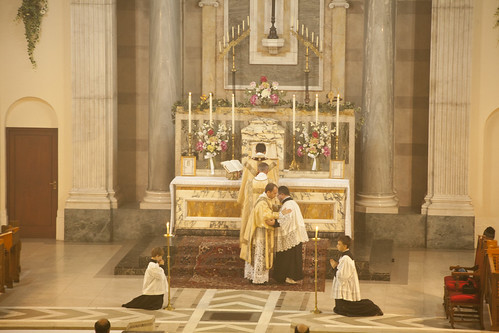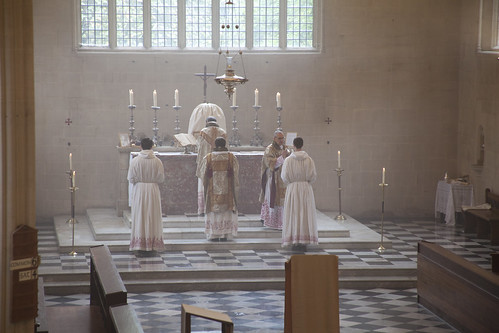An attack on the Monsignorial title which is so vividly displayed in his byline, and often on the paper's front page, and which has stood him in such good stead against criticisms over the years:
...there is the Church-inspired colour-coded ranks, which Holy Father Francis has now begun to eliminate,
Pope Francis has done nothing of the kind - unless you count his failure to wear red shoes, something to which I have always refused to attribute any tremendous symbolic significance. Red shoes are not the kind of symbol Pope Francis is interested in: that's exactly why he doesn't bother wearing them.
...separating priests from people in a way that subordinates sacramental reality to social protocol, distinctive dress, and pompous titles.
Yes, we're looking at you, Monsignor.
 |
| ... and from the subdeacon to the Master of Ceremonies, who takes it to servers and those in choir. |
Sadly, as also with the emerging identity of the episcopate, and indeed of the Church itself, the "priesthood as we currently have it in the Church" owes its love of titles and carnival costume, and its desire to rule rather than serve, to the contagion of Holy Roman Empire's feudal system of government.
Naturally the Church is influenced by every era, but the structure, and indeed the terminology, of the Curia, and liturgical vestments, are derived from a much earlier era, that of the late Roman Empire. No secular officials were wearing copes, albs, chasubles or dalmatics under the Holy Roman Empire, for the Church to imitate. The desire to rule rather than to serve, sadly, is something which Our Lord had to combat among the Apostles before His Passion: it is part of human nature.
A disguised attack on St John Paul II:
the latest letter from that Congregation [sc. Divine Worship] ...forbidding the priest from sharing that sign [of peace] with the faithful assembled at Mass.... It makes a nonsense not only of Christ's own example [really?], but of the reminder in John Paul II's Veritatis Splendor that "Jesus' way of acting, and his words, his deeds and his precepts, constitute the moral rule of Christian life" (n.20).
Nice: until one realises that under St John Paul II the Congregation for Divine Worship made exactly the same ruling. Redemptionis sacramentum, 2004:
[72.] It is appropriate “that each one give the sign of peace only to those who are nearest and in a sober manner”. “The Priest may give the sign of peace to the ministers but always remains within the sanctuary, so as not to disturb the celebration."
So was he a fool, or a hypocrite? Neither, because Jesus did not give us the kind of detailed guidance which would obviate the need for the Pope to govern the liturgy.
 |
| The hierarchy is indicated by who has the upper hand: here the celebrant puts his hands on the deacon's shoulders, the deacon places his hands on the celebrant's elbows. |
Inadvertent attack on the liturgical reform.
Is the real reason for the is prohibition on the priest entering into the congregation's Sign of Peace the fact that a true 'embrace' is ordered in the rubric for the concelebrating priests. [No, it isn't.] No handshake here .... We can't have the laity imitating priestly gestures at Mass, so they are to be rationed to a handshake. What small child ever expresses its love for its parents by a handshake?
You've said it, Basil. The handshake was introduced in the reform, in order to make possible the physical participation of the congregation in the Kiss of Peace, without asking them actually to kiss - or rather, as the 'kiss' has developed in the Latin Church, either to embrace, or to pass round the Paxbrede, kissing it in turn. The handshake is indeed very unsatisfactory. But the problem was not that the embrace was 'priestly': it spreads from the celebrant to the lay people in the sanctuary, at the Traditional Mass, such as religious sitting in choir, and the servers. The problem was that it was regarded by the reformers as impractical: as indeed it would be. Attempts to substitute spontaneous hugs for handshakes at the Peace in the Novus Ordo today never fail to cause some members of the congregation acute embarrassment.
Inadvertent attacks on the abuses he supports.
The distribution of the Chalice to large congregations, such as on Sundays, has been consistently opposed by the Church. See, for example, Redemptionis Sacramentum 102 (for a fuller treatment, see the Position Paper on the subject). Equally, the routine use of Extraordinary Ministers of Holy Communion is forbidden in Redemptionis Sacramentum 88. Heedless of the common sense at work here, Loftus blunders in:
Look at the requirement [in the Instruction] that Eucharistic Ministers may give out Communion, but may not purify the sacred vessels. Did it never occur to anyone that some parishes have six or eight Eucharistic Ministers with chalices which must then be drained by one priest, not once but at three Sunday Masses, before he then continues to drive around the parish?
Perhaps it has occurred to them, Basil...
 |
| In the Dominican Rite the Paxbrede, a silver disk with a handle on the back, is kissed by the celebrant, and then tendered by the deacon to others in the sanctuary in succession. |
The whole article is an attack on a document of the Congregation for Divine Worship, which has emerged following many years of discussion, notably, on the subject of the Pax, at the Synod of Bishops in 2009, in which the Congregation was asked to study possibility of moving the Pax to an earlier point in Mass. The outcome of all this, well into the pontificate of Pope Francis, cannot be regarded as other than an act of his pontificate. If Pope Francis didn't personally involve himself in the formulation of the document, he at least took the decision to let his officials get on with it in the way which he knew they would: in line with earlier Instructions. The idea that there is some kind of conflict between the 'spirit of Pope Francis' and Curial obstructors, on these issues, is a complete fantasy. In reality, it is Pope Francis who is the target of Loftus' wrath.
It may be worth noting that Communion under Both Kinds is not widespread in Latin America. There is no earthly reason to suppose that Pope Francis has any particular sympathy with the kinds of liturgical abuse which has become prevalent in Western Europe and North America. Why should he?
The issues discussed here are discussed in much greater detail in two recent position papers:
On the Kiss of Peace
On the Reception of Holy Communion under the Species of Bread Alone.
As a service to the public, I have put together quotations on a range of themes from Loftus' published writings, mostly his Catholic Times columns, in a dossier here, and made one of his most theologically egregious articles, on the Resurrection of Our Lord, available here.
Support the work of the LMS by becoming an 'Anniversary Supporter'.


No comments:
Post a Comment